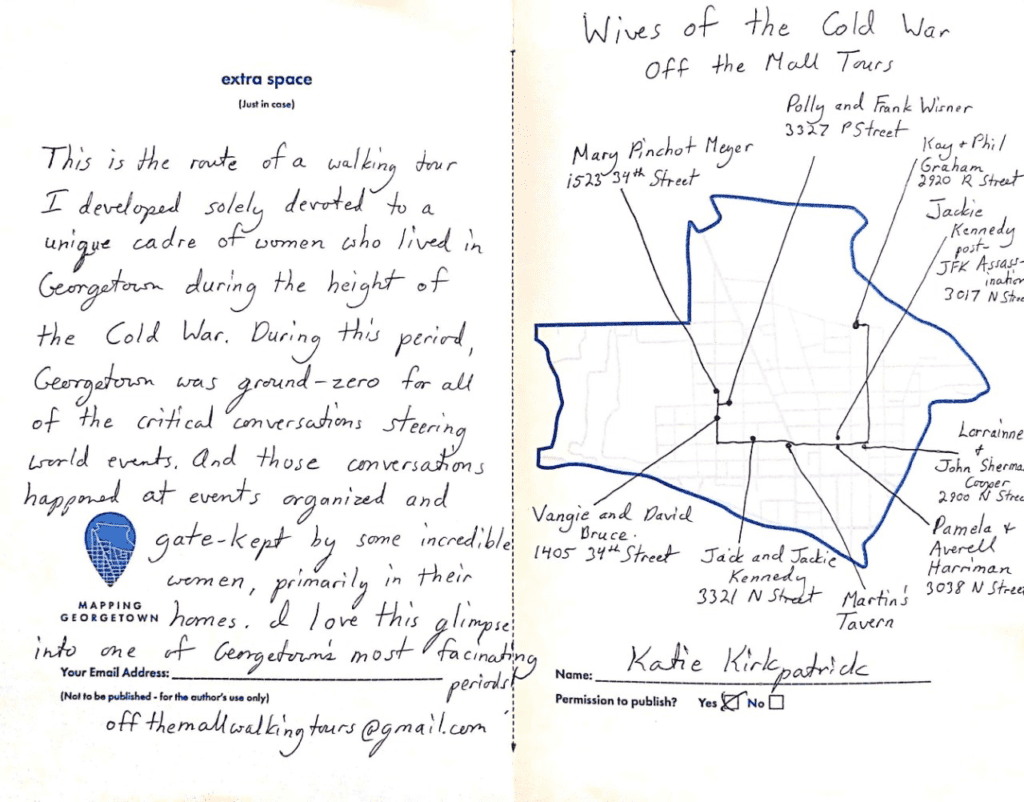Mapping Georgetown: Walking Tours of Women of the Cold War
By • March 21, 2022 0 1618

Married to CIA Director Cord Meyer, Mary Eno Pinchot Meyer (1920-1964) was an American painter who lived in Washington, D.C. After she and the nation’s top spook divorced, she became involved romantically with – you guessed it – President John F. Kennedy.
Tragically, she was later murdered on the C&O Canal towpath on October 12, 1964. A suspect, Ray Crump, Jr., was arrested and charged with her murder but was ultimately acquitted. According to Wikipedia, Pinchot Meyer – one of many intriguing Georgetown women of the Cold War — later became the subject of numerous books and articles, including a full-length biography by journalist Nina Burleigh.
Our Mapping Georgetown project was most intrigued and fascinated by the story-map we received from Katie Kirkpatrick founder of “Off The Mall Walking Tours” and specialist in the many Georgetown “wives of the Cold War,” who played key historical roles, often behind the scenes. Every other Thursday at 2:00 p.m., Kirkpatrick guides a walking tour called “Wives Who Won the Cold War.”
Katie Kirkpatrick’s Story-Map:

Katie Kirkpatrick’s story-map for the Mapping Georgetown Project. Courtesy Mapping Georgetown.
“This is the route of a walking tour I developed to a unique cadre of women who lived in Georgetown during the height of the Cold War. During this period, Georgetown was ground-zero for all of those critical conversations steering world events. And those conversations happened at events, organized and gate-kept by some incredible women, primarily in their homes. I love this glimpse into one of the Georgetown’s most fascinating periods.”
- Mary Pinchot Meyer, 1523 34th St.
- Polly and Frank Wisner, 3327 P. Street
- Kay and Phil Graham, 2920 R. Street
- Jackie Kennedy, post JFK Assassination, 3107 N Street
- Vangie and David Bruce, 1405 34th Street
- Jack and Jackie Kennedy, 3321 N Street
- Martin’s Tavern
- Lorraine and John Sherman Cooper, 2900 N Street
- Pamela and Averill Harriman, 3038 N Street
About Katie Kirkpatrick:

From Kirkpatrick’s “Off The Mall Walking Tours” website. Courtesy OtmDC.com.
Kirkpatrick’s “Off the Mall” website (https://www.otmdc.com/) helps tell her story and how she became intrigued by the subject:
Katie Kirkpatrick is proud to call herself a DC resident since 2002. She moved to the capital after college for graduate school, and then worked in government for many years. However, history was always her first love. She started her touring career by giving historical ghost tour pub crawls, and discovered a passion for sharing the varied and layered history of the capital area. So, she started her own company, drawing upon her interests in unique stories, a flair for costuming, and her love of DC.
Her mission is to introduce locals and tourists alike to the DC that awaits “Off the Mall” and into the neighborhoods of this fascinating, energetic city. After one of our tours, our guests are delighted with their newfound understanding of its multi-layered and multi-cultural heritage.
Some Internet Sleuthing Reveals More…
Seeing Kirkpatrick’s list made me curious, so I went online to find out more about some of the intriguing figures on her walking tour. Most Georgetowners are perhaps aware of the key roles of Pamela Harriman or Katharine Graham, but do they know about?:
Evangeline Bruce (1914-1995). She held an intellectual salon reputed to be among the most continuous and celebrated in Washington throughout the Cold War. In “Vangie Bruce’s Diplomatic Salon,” historian Kenneth Weisbrode described her influence as among the most continuous and celebrated.” He wrote: “In London in the 1960s,” ‘Vangie’ was named the ‘Number One American hostess… by rank and ability; in Washington she was ‘dubbed the ‘Fourth Mrs. B’ after Washington’s three legendary salonnieres, Mildred Bliss, Virginia Bacon and Marie Beale.”
Frank Gardiner Wisner (1909-1965). He was one of the founding officers of the CIA who played a major role in the agency’s operations throughout the Cold War 1950s. A search through Wikipedia reveals that Wisner began his intelligence career in the Office of Strategic Service (OSS), the precursor to the CIA, during the Second World War. After the war, he headed the Office of Planning Coordination (OPC), one of the OSS successor organizations, from 1948-1950. In 1950, the OPC was placed under the CIA and renamed the Directorate of Plans, first headed by Allen Dulles. During the Korean War, Wisner succeeded Dulles in 1951 when President Truman appointed Dulles as Director of Central Intelligence. Wisner remained as Deputy Director of Plans (DDP) until September 1958, and retired from the Agency in 1962. He took his own life in 1965.
—
Thank you, Katie, for sharing these incredible tales resulting from your zeal for gathering such interesting and compelling material. We’re proud of you and your efforts and are eager to stay tuned for more.
To learn more about the Mapping Georgetown project see https://georgetowner.com/articles/2021/07/19/marilyn-butlers-vision-for-mapping-georgetown/.
To submit your Georgetown recollections to Mapping Georgetown go to www.mappinggeorgetown.com or visit the Georgetown Public Library to pick up a physical map-story form to fill out.
Marilyn Butler can be reached at: marilyn.butler@gmail.com.

